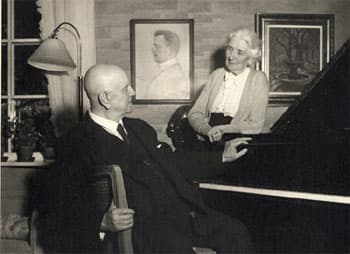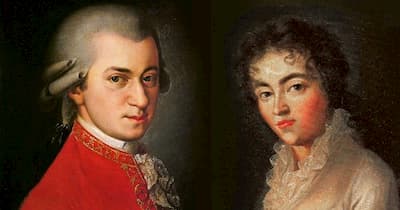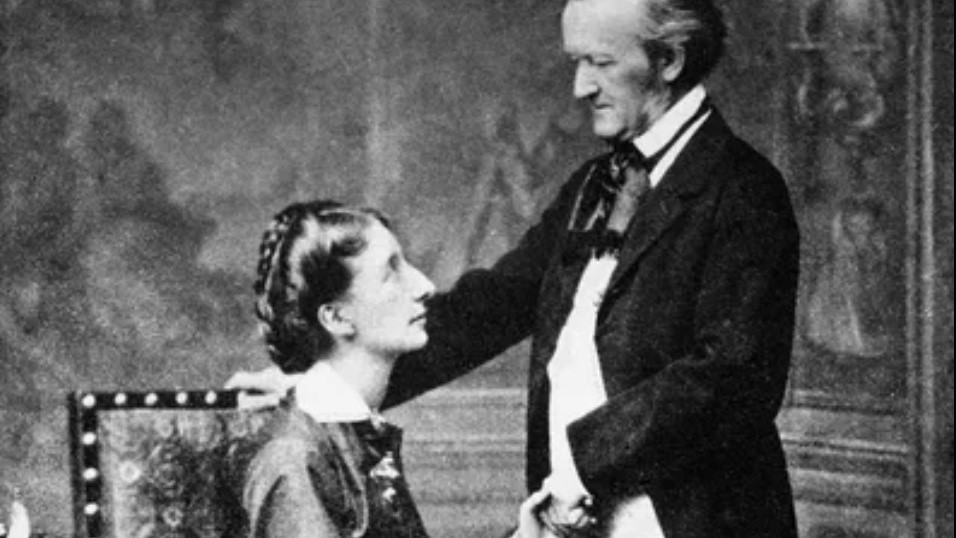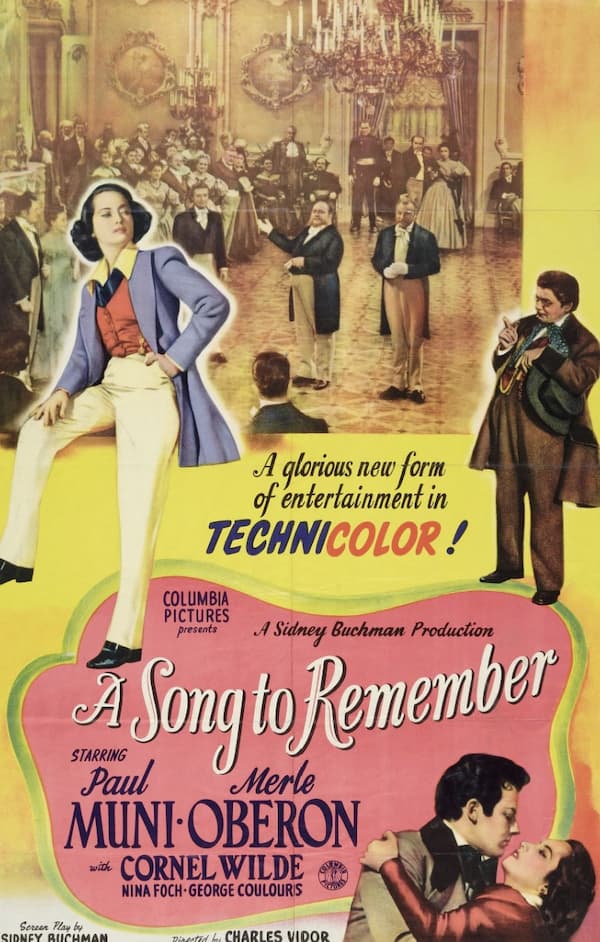For a variety of reasons, it can be difficult being married to a composer.
However, sometimes composers find spouses who support them, encourage them, and, if they’re very lucky, inspire them to write incredible music.
In this two-part series, we’re looking at what made ten of the happiest marriages in classical music so successful.
10. Jean Sibelius and Aino Järnefelt

Aino and Jean Sibelius
Aino Järnefelt was born in 1871 to an artistic family.
When she was eighteen, her older brother brought home a college friend named Jean Sibelius. The two fell in love and were married in the summer of 1892.
Between 1893 and 1911, the Sibeliuses had six daughters. In between babies, in 1904, they built and moved into a country home called Ainola, after Aino. They would live there for the rest of their marriage.
Life together wasn’t perfect. Jean battled with alcoholism, and Aino was often stressed by his addiction and money troubles.
Jean Sibelius at Home 1927/1945 with Aino, Heidi and Margareta (Historic Footage)
But their marriage lasted for sixty-five years, making it one of the longest-lasting in classical music history. Jean Sibelius died in 1957, and Aino died in 1969. The two are buried together in the Ainola garden, which is the most peaceful gravesite imaginable.
Aino once described her relationship with her husband like this: “I am happy that I have been able to live by his side. I feel that I have not lived for nothing. I do not say that it has always been easy – one has had to repress and control one’s own wishes – but I am very happy. I bless my destiny and see it as a gift from heaven. To me, my husband’s music is the word of God – its source is noble, and it is wonderful to live close to such a source.” Learn more about their marriage from our article “A Nordic Fairytale”
9. Wolfgang Amadeus Mozart and Constanze Weber

Mozart and Constanze
When he was twenty-one, Wolfgang Amadeus Mozart fell in love with a singer he was teaching named Aloysia Weber. However, they were both young, and the relationship didn’t pan out.
A couple of years later, Mozart began rooming with the Weber family when he and they were living in Vienna. Over the summer of 1781, Mozart began falling for Aloysia’s nineteen-year-old sister Constanze.
Mrs. Weber soon realised that Mozart was interested in her daughter, and so, in the interests of propriety, she asked him to leave. They continued their romance for a year (albeit with a lover’s quarrel and brief breakup in the spring of 1782).
That summer, it is believed that the two lovebirds embarked on a brazen physical relationship, probably going so far as to move in together. Mozart wrote to his controlling father, who was discouraging of the match, that “All the good and well-intentioned advice you have sent fails to address the case of a man who has already gone so far with a maiden. Further postponement is out of the question.” His father’s approval arrived in the mail the day after their wedding, which happened on 4 August.
Wolfgang and Constanze were married from 1782 until his death in 1791. They had six children during that time, although only two survived infancy.
After Wolfgang died in December 1791, Constanze spent the rest of her life advocating for her husband’s legacy. She would have other lovers, but she never forgot Wolfgang. Touchingly, she and her second husband worked together on a biography of Mozart in the 1820s.
8. Richard Wagner and Cosima Liszt von Bülow

Richard and Cosima Wagner (photograph by Fritz Luckhardt, 9 May 1872)
Francesca Gaetana Cosima Liszt was born in 1837, the daughter of pianist Franz Liszt and his lover, Countess Marie d’Agoult.
Cosima, as she was known, was sheltered as a child. When she was twenty, she married a twenty-seven-year-old student of her father’s named Hans von Bülow. Although she had two children with him, she never really fell in love with him.
In the 1860s, Hans von Bülow began promoting the work of composer Richard Wagner. In 1864, Cosima fell in love with Wagner, and Wagner with her. Wagner got a job for von Bülow in Munich, and the three of them lived together in close proximity.
In 1865, nine months after a passionate lakeside vacation, Cosima gave birth to a daughter, naming her Isolde. A few months later, von Bülow conducted the premiere of Wagner’s opera Tristan und Isolde, aware of his wife’s affair but unsure what he wanted to do about it.
Wagner: Isoldes Liebestod / Rattle · Berliner Philharmoniker
In June 1869, after Cosima gave birth to her and Richard’s third child, von Bülow realised that the marriage was over and finally agreed to grant Cosima a divorce. She and Wagner were married in August 1870. She wrote in her journal, “May I be worthy of bearing R’s name!”
Cosima was married to Richard Wagner for twenty-three years, faithfully recording his activities, thoughts, and ideas in her journal. She was so overcome with grief after he died of a stroke that she laid on her husband’s coffin before it was buried until her son made her come back into the house.
Despite the intensity of her grief, she eventually emerged from it to become the head of the Bayreuth Festival, devoted to celebrating and promoting her husband’s music and ideas. She died in 1930 after years of deteriorating health.
7. Nikolai Rimsky-Korsakov and Nadezhda Purgold

Nadezhda Purgold
Nadezhda Purgold was born in 1848 in St. Petersburg. She began playing piano when she was nine years old, then went to study piano, theory, composition, and even orchestration at the St. Petersburg Conservatory.
As a young woman, she often played the piano at various soirees and salons. She became the darling of Borodin and Mussorgsky, who called her “our darling orchestra.”
One of the men who was especially taken with her was Nikolai Rimsky-Korsakov, who she met in 1868 and who she found to be extremely kind. They got engaged in December 1871 and married in 1872, with Mussorgsky serving as witness.
The two had seven children. In the hubbub of motherhood and housekeeping, she composed less and less, but she was a hugely important sounding board for her husband, who treated her as his creative equal.
She was always on hand to keep his ego in check. Although she loved her husband dearly, she didn’t lionize him. One famous story is that at Rimsky-Korsakov’s funeral, Stravinsky began crying, seeing him in his coffin. Nadezhda asked, puzzled, “Why so unhappy? We still have Glazunov.”
After her husband’s death, Nadezhda devoted herself to preserving his legacy, serving as editor of his remaining literary and musical output.
6. John Cage and Merce Cunningham

John Cage and Merce Cunningham © bpb-us-e1.wpmucdn.com
Musician John Cage married artist Xenia Kashevaroff in the spring of 1935. Their marriage was destined for failure: Cage loved Xenia, but he was attracted to men. Their relationship began falling apart a few years after the wedding, and they divorced in 1945.
In 1940, while working as a composer and accompanist at the Cornish College of the Arts in Seattle, Cage met a striking young dancer and choreographer named Merce Cunningham.
Around the time of his divorce, Cage became romantically involved with Cunningham. The two ended up staying together for half a century. Although they were obviously never able to legally get married, their relationship was a marriage in everything but name.
The two served as each other’s muses. Cunningham’s influence inspired Cage to work with modern dance. Together, they explored ideas about onstage chance, employing coins and dice to suggest different choreographic elements. Cage also pursued these ideas in his compositions.
Merce Cunningham: On John Cage
On the night of 11 August 1992, while preparing tea for himself and Cunningham, Cage had a stroke. He died the next day. Cunningham died in 2009.
The intensity of their love is at its most potent in their love letters. In July 1943, Cage wrote, “My whole desire is to run up and down the sea coast looking for you.”
There are more great love stories coming in the finale of this countdown, including a forty-five-minute symphonic love letter and arguably the most famous marriage in classical music history, so don’t miss it.
For more of the best in classical music, sign up for our E-Newsletter


